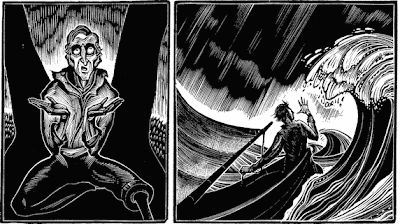
The Paris Review currently features a short piece on graphic artist Lynd Ward written by Art Spiegelman, author of the Pulitzer Prize-winning graphic memoir Maus: A Survivor’s Tale. The 1971 meeting in upstate New York between scruffy young fan and established artist, as often happens, doesn't turn out as hoped but it did help spark Spiegelman's own graphic career. This fond memory is excerpted from his introduction to Lynd Ward: Six Novels in Woodcuts, a two-volume set published by The Library of America on October 14, 2010.
... It seems natural now to think of Lynd Ward as one of America’s most distinguished and accomplished graphic novelists. He is, in fact, one of only a small handful of artists anywhere who ever made a “graphic novel” until the day before yesterday. The ungainly neologism seems to have stuck since Will Eisner, creator of the voraciously inventive Spirit comic book of the 1940s, first used it on the cover of a 1978 collection of his seriously intended comics stories for adults, A Contract With God. It was a way to distance himself from the popular prejudices against the medium, and he often cited Ward’s 1930s woodcut novels as an inspiration for his work and for the euphemism. But Ward’s roots were not in comics, though his work is part of the same large family tree, belonging somewhere among the less worm-ridden branches of printmaking and illustration.
... In 1970, I b riefly met Lynd Ward at the opening of a small Binghamton, New York, gallery show of his prints. I was a twenty-two-year-old cartoonist and told him how much I admired his woodcut novels. As I recall, I was by far the youngest and scruffiest person at the opening (he was just a few years older than I am now), and he expressed surprise that I even knew the books. I asked what newspaper comics had been important to him, and he explained that he hadn’t been allowed to read them as a child. When pressed, he expressed appreciation for Hal Foster’s Prince Valiant, which he discovered as an adult.
riefly met Lynd Ward at the opening of a small Binghamton, New York, gallery show of his prints. I was a twenty-two-year-old cartoonist and told him how much I admired his woodcut novels. As I recall, I was by far the youngest and scruffiest person at the opening (he was just a few years older than I am now), and he expressed surprise that I even knew the books. I asked what newspaper comics had been important to him, and he explained that he hadn’t been allowed to read them as a child. When pressed, he expressed appreciation for Hal Foster’s Prince Valiant, which he discovered as an adult.
 riefly met Lynd Ward at the opening of a small Binghamton, New York, gallery show of his prints. I was a twenty-two-year-old cartoonist and told him how much I admired his woodcut novels. As I recall, I was by far the youngest and scruffiest person at the opening (he was just a few years older than I am now), and he expressed surprise that I even knew the books. I asked what newspaper comics had been important to him, and he explained that he hadn’t been allowed to read them as a child. When pressed, he expressed appreciation for Hal Foster’s Prince Valiant, which he discovered as an adult.
riefly met Lynd Ward at the opening of a small Binghamton, New York, gallery show of his prints. I was a twenty-two-year-old cartoonist and told him how much I admired his woodcut novels. As I recall, I was by far the youngest and scruffiest person at the opening (he was just a few years older than I am now), and he expressed surprise that I even knew the books. I asked what newspaper comics had been important to him, and he explained that he hadn’t been allowed to read them as a child. When pressed, he expressed appreciation for Hal Foster’s Prince Valiant, which he discovered as an adult. I didn’t share his enthusiasm—I thought Foster’s work, with its captions positioned safely beneath each of the stately illustrations on his Sunday pages, was barely comics at all —but we went on to find common ground in our mutual esteem for the great old socialist cartoonist, Art Young, before he turned back to talking to his grown-up friends.
... When walking through that Binghamton gallery show back in 1971, I regretted that no original prints from Ward’s woodcut novels were part of the exhibit, but I remember slowing down to notice that a number of the prints on display depicted trees and forests. I thought about the poetry of patiently carving into a dead tree to make a print on paper that commemorated the once-living thing. One beautifully structured print stayed with me (I later found it again, reproduced in Storyteller Without Words): a panoramic treescape of a young man in shadows, groping and climbing through the dense neuronal wickerwork of dappled trunks and branches, carefully exploring and working his way through the maze of marks that surround him.
I’ve recently been told that it was intended to be a picture of the nature writer, John Burroughs, but I’d thought of it as a moving self-portrait of the artist embedded in the wood, seeking slivers of light in the darkness and carving out a new medium. The print was called “The Pathfinder.” ...
(Art Spiegelman's work also includes the startling Shadow of No Towers, a graphic novel about September 11, 2001. His most recent book of comics is Breakdowns: Portrait of the Artist as a Young %@&*!. Art by Lynd Ward reproduced from the Paris Review.)






No comments:
Post a Comment